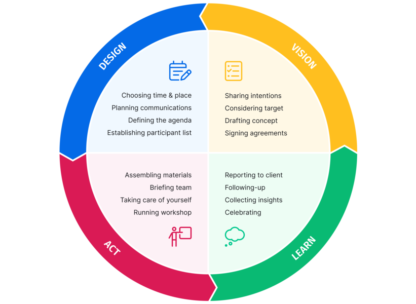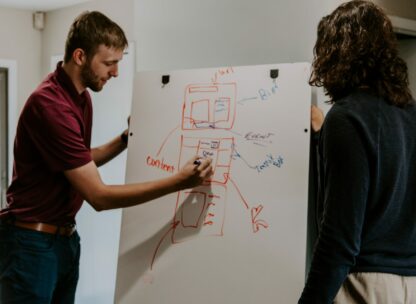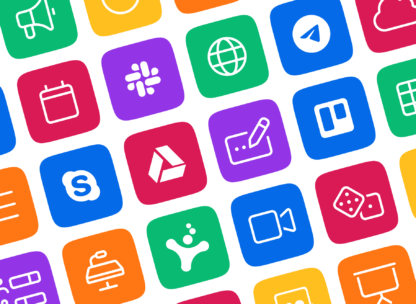How to improve your collaboration skills and be a better collaborator

Achieving effective collaboration with your colleagues at the workplace can improve the efficiency, happiness, and productivity of your team. However, real collaboration is easier said than done.
How many times have you found it tough to work with others or been frustrated by working processes? These are symptoms of poor collaboration skills and it might be time to reconsider how you and your team collaborate and work towards your shared goals.
It’s important to note that collaboration has fundamentally changed over time, and it is not as simple as it sounds. You can’t make collaboration in the workplace happen overnight. It is a process that often requires open discussions, building skills, and an honest appraisal of working practices.
A great place to start is in first helping your employees to build their skills while creating a work environment that supports those skills. An environment that inspires your employees towards better collaboration also helps build resiliency, productivity, and happiness.
Whether you are a hybrid, fully remote, or co-located team, you should invest in improving workplace collaboration.
In this post, we’ll explore what good collaboration is, show you some of the most important collaboration skills and give you practical tips for improving team collaboration. Let’s dive in!
- What is effective collaboration?
- Why is collaboration in the workplace important?
- What skills do you need to be a great collaborator?
- How to improve your collaboration skills
- How to improve team collaboration
What is effective collaboration?
The simplest way to understand collaboration is that it is effective teamwork. A team with good collaboration skills can work together effectively enough to produce better goods with it. Whether virtually or in person, your teams need to be connected. You can use communications tools or cloud-based servers to build collaboration among your team members.
Besides this, there are many other ways to create and foster a collaborative workplace. The most significant indicator of a collaborative workplace is where your employees feel safe, seen, and heard. Your company should have standardized systems and collaboration processes to run efficient work sessions and meetings.
Remember that all group efforts should extend throughout your organization. From junior staff to executives, collaboration principles should be lived by everyone. Collaboration doesn’t work if not everyone in the team is living its core elements and thinking about how to better work together.
Why is collaboration in the workplace important?
You might have a team of diverse individuals with different skills, talents, and expertise. To bring out the best from them, you need to ensure that the door to collaboration is always open to them; nothing should come in their way. That way, you will utilize their abilities, knowledge, experience, and skills to the maximum capacity. This will not only help them, but your organization will also benefit from it in the long run.
Collaboration can especially be helpful for fast-tracking projects as employees with combined skills and expertise can get tasks done more efficiently. More minds mean more input, so if one employee cannot do a job, the other would help them get through.
When your employees know each other and understand how their teams think and work, they can maintain a mutually beneficial approach to work. Here are a few of the benefits you can see from improving workplace collaboration on your team.
- Enable innovation
- Stronger teams
- Better customer experience
- More skilled and knowledgeable employees
- Open and productive team culture
Enable innovation
When all the employees work together with their collaborative skills, abilities, and knowledge, they can produce more incredible ideas that lead to innovation. Without collaboration, you might never be able to achieve innovation.
This is why companies are increasingly starting to form teams with people from different departments of the organization together in brainstorming sessions. As a result, they resolve issues more effectively and develop innovative ideas that benefit the business. A great team is the starting point for innovation – meaningful collaboration is what helps that team achieve its goals and innovate.
Stronger teams
In one way or another, every organization has been working to build effective communication among their teams and employees. What is the reason behind it? All the efforts they make are to form teams with more robust social networks. It gives the employees a strong sense of purpose when they work towards the same goal with the collaboration of their minds.
It also enables team members to divide work and fill in each other’s skills gaps. This instills an unquestionable strength in the team. Poor collaboration makes for unhappy, groups that aren’t resilient to change.
Better customer experience
All teams and organizations encounter problems that affect their customers or clients. When issues occur, it’s a real test of how well your team collaborates.
Teams that collaborate make it easier to serve customers and solve problems since they provide a streamlined service that solves problems faster and more effectively. What’s more, a collaborative mindset is also helpful when it comes to working with clients and customers. When your team sees these relationships as collaborative, rather than adversarial or purely transactional, great things happen!
Simply put, effective collaboration can help create happy customers and more productive partnerships too!
More skilled and knowledgeable employees
When people work together, they get to learn new skills, techniques, and knowledge from each other. Thus, it contributes to the overall personal and professional development of the team members.
People are also challenged to articulate, learn and think about their competencies when collaborating with people from different teams. Moreover, they also get to build a better understanding of their own weaknesses and strength. After all, self-awareness is the first step to improvement.
Open and productive team culture
The culture of a team is formed by all of the interactions and working practices between the people in that group. When we collaborate more effectively, we break down barriers, build bonds and learn to celebrate everyone on the team. Collaboration is one of the major contributing factors to strong team culture. If your company culture is suffering, look to how you collaborate – it’s usually where your biggest problems are!
What skills do you need to be a great collaborator?
Collaboration skills develop in individuals and teams over time as they work together. While effective team work can emerge organically, it’s also possible for bad habits to come up too.
To help your group meaningfully build their collaboration skills and be great collaborators also requires support from leaders and a supportive work environment. Without these soft skills that employees learn through interaction and working on tasks towards a common goal, work can stall. You can even find your team unhappy, unproductive, and unable to grow.
It really pays to be proactive in improving your collaborative skills and think about how you work together as a team. Here’s a list of some of the skills you’d need to develop to be a better collaborator.
Open-mindedness
When working with a team, you need to have an open mind towards your team members’ ideas. Learning to accept and explore other people’s ideas is one of the most critical collaborative skills. Getting in the same room with 10 other people without an open mind means you won’t get any results. When you discuss projects, every member will have a unique thought process, and they should be encouraged to share those ideas with others.
Having an open mind will allow you to look at other people’s perspectives thoughtfully, instead of being rigid and rejecting them. You will also be able to choose the best option, whether it is yours or someone else’s.
Communication
The whole point of collaboration is to encourage clear and thoughtful communication. To make the cooperation a successful experience, you need to maintain effective communication. You need to be expressive and have the ability to share your thoughts with other people whenever required.
However, not everyone can share their thoughts in groups or meetings – they get uncomfortable. On the other hand, some people have no trouble speaking in front of a large audience. So team members need to enable different communication styles to make the most out of their collaboration. It is possible that and adapting the way you communicate accordingly.
Adaptability
No matter how much you plan, some things still might not go as planned. So to maintain collaboration, your team members need to have adaptability. When a problem occurs, there’s a shift in priorities, and obstacles delay progress, it will send the whole project into chaos.
In a situation like this, many employees give up as they are not adaptable. However, you cannot let that happen at your workplace. So, to get through stressful situations, your people will need to adapt to new work conditions at short notices.
Adaptability is all about being flexible and open to change while taking action. It’s an important skill to learn and will help you both inside and outside of workplace collaboration.
Long-term thinking
When it comes to collaboration, you cannot avoid long-term thinking. To allow a successful partnership, you need to envision and focus on the result of your team’s work. So how can your employees work towards a shared purpose or common goal without recognizing what they’re trying to achieve?
When they know how their contributions are leading them towards the goal, they would have better collaboration. Employees who want to work on and improve their collaboration skills would need to do that by gaining a clear understanding of their role in the project’s scope. When they have better knowledge, they can perform better in a given project.
Debate
An effective collaborator will be capable of productively and tactfully coming up with debate ideas that can bring about healthy discussion. In the meetings where you’re trying to figure out the direction of your project, debates can spark up innovative ideas. Your project team will come up with good ideas, and the not-as-good ideas will take the backseat.
This will allow the team to make the project move forward more efficiently. However, acquiring the ability to debate can be very difficult. Not everyone can lead a debate, especially if an emotional attachment is involved. Remember that using facilitation techniques to encourage healthy, respectful debate can be a key factor too!
Active listening
Working in a team requires you to have an open mind and open ears. You need to have the capability to listen to others while you work closely with them. For example, when a team member gives feedback, idea, or advice about the project, you need to listen closely, pay attention and be considerate and respectful.
You may think your ideas to lead the project are superior, but that’s because you haven’t given others the chance to share their ideas. This is why active listening is essential for collaboration. If you’re working solo, you may have to settle with your own idea, but when in a team, you can take your colleague’s opinion and benefit from it while you can.
How to improve your collaboration skills
Effective collaboration can be a complicated process. Remember that all collaboration is the coming together of two or more people, all of whom have their own ideas, challenges, and goals. Balancing all of those elements isn’t easy!
Navigating all these moving parts and working at your best within a team can be tricky, but there are lots of ways you can improve as a collaborator.
One of the best ways to start is to first be aware of your collaboration skillset and take steps to improve where you can. Here are some of the ways you can practically improve your collaboration skills.
- Practice your core collaboration skills
- Clarify how you want to collaborate
- Identify obstacles and co-create solutions
- Learn from others (whatever their field!)
- Explore other perspectives
- Learn how to navigate knowledge gaps
- Play collaborative games with your team!
Practice your core collaboration skills
All of the above collaboration skills – from active listening to open-mindedness – can be improved by practicing them!
Remember that not every aspect of collaboration comes naturally to everyone. That’s okay, but it’s important to take the time to reflect on where you might want to improve and practice these skills.
If you’re not a great listener, try some active listening techniques and research the subject. If you simply haven’t had the chance to collaborate regularly and feel a bit rusty, see how you can get involved in projects big or small at work.
When it comes to practicing better collaboration, it’s often helpful to start with small practical steps. Get a little more involved in group discussions, contribute where you can, and practice asking what others need from you. You’ll be surprised by how small steps like learning to collaborate better over email can have ripple effects across your working life.
Clarify how you want to collaborate
As with any group process, different people might have different ideas of how they want to collaborate and work together to achieve their goals. One of the best ways to improve your skills as a collaborator is to clearly state how you best collaborate and what you need in order to collaborate effectively. Doing this collectively means you can lean into what works and either avoid or improve what doesn’t!
What I Need From You is a method designed to help teams clearly articulate their needs, request help, and respond to the needs of others. It’s a great way to improve how teams work together and if you get into a habit of being clear about your needs, you’ll be a much better collaborator too!
Identify obstacles and cocreate solutions
There can be many obstacles to collaboration – some of which are easy to overcome, while others might be hidden from view. Learning to correctly identify the obstacles to collaborating with others is a vital part of the process. If an obstacle isn’t known to you, it’s extremely difficult to resolve it!
Speedboat is a simple, visual method for identifying obstacles and turning them into action points. Start by drawing or using an image of a speedboat – think of this speedboat as a representation of group collaboration. Then, ask the group to brainstorm and add anchors to the boat to show what is holding back effective collaboration.
As with any collaborative process, remember it’s best to involve all those people involved and work on this together. Once you’ve identified all those things that are holding collaboration back, you can then figure out what you might do to remove those anchors and push your speedboat forward!
Learn from others (whatever their field!)
Effective collaboration is the goal of every team, no matter the sector or industry. While you should learn from others in your organization and sector, you can go further.
Learning how Steve Jobs, Barcelona Football club, or Pixar learned to enable collaboration is a great way to improve your collaboration skills. I’ve often been inspired by stories from outside my field and the change in perspective can be especially useful.
When reading Creativity Inc. – a book about removing obstacles to creativity and progress – I was massively inspired by how Pixar used radical candor and a commitment to creating a psychologically safe environment in their Braintrust meetings.
Seeing how they overcame challenges to speaking up and enabling collaboration made me think about how I might do the same in my working relationships. Read widely and outside your industry and you might be surprised at how you can improve your skills!
Looking for an activity to help collectively surface learnings from people we respect and admire? Role-playing as our role models is a great way to share knowledge from the group in a fast and fun manner!
Explore other perspectives
A large part of great collaboration is finding ways to see things from the perspectives of others. Being stuck in a particular mindset or being unable to empathize with your teammates is a major obstacle to collaboration. Being more open-minded and developing a willingness to see things from other points of view is a key collaboration skill.
There are heaps of creative thinking exercises you can use to help you be more open-minded and willing to change your perspective. Flip It is a great method that can show you and your team that our points of view are made, not born. Sometimes, our perspectives need to change, or we can benefit from exploring other points of view. Flip It helps a team think radically and be open to change – a great way to improve team collaboration!
Learn how to navigate knowledge gaps
Knowledge gaps can be a collaboration killer, particularly with cross-discipline teams. Sometimes we can take some parts of our knowledge for granted, or assume others know things implicitly. These gaps in knowledge, understanding, and familiarity can be barriers to great collaboration.
Helping a group understand the impact of knowledge gaps and finding ways to bridge them can massively improve collaboration on your team. With 500 year gap, ask participants to role-play a conversation between someone from today and someone from 500 years in the past. By seeing how knowledge gaps can be navigated more successfully with a change in attitude, everyone in your team can improve their collaboration skills – whether they’re time travelers or not!
Play collaborative games with your team!
Not all collaborative processes are massive projects involving multiple departments, budgets, and strict timeframes.
Team building games and activities that involve working with others towards a common goal all require collaboration and teamwork – even if that goal is winning the game! In fact, play is a great route towards improving collaborative skills and teaching important lessons about collaboration.
In the Blind Square – Rope game, teams must collaborate in order to make a length of rope into a perfect square while blindfolded. By asking participants to make a plan before then enacting the plan, you can collectively practice many aspects
How to improve team collaboration
If you want your company to succeed and not have any unhappy employees or unfulfilled projects, you need to improve your teams’ collaboration skills. Invest your time and resources to increase the productivity of your employees with the help of better collaborative skills.
You won’t need to spend a big budget or make huge changes either. Instead, you can promptly start with these 4 simple ways to build better collaboration in the workplace.
- Clearly state your company goals
- Set clear expectations
- Clarify roles
- Recognize and utilize people’s strengths
- Take time to get to know one another
Clearly state your company goals
You have a great team, but they cannot collaborate because the aim of their collaboration is not clear to them. An unclear company goal and vision can become a big challenge for your team. They will be confused about their tasks and might end up working in the opposite direction. When they won’t know what they’re working on, how would they use their collaborative strengths to work towards it?
So, before assigning a project, make it a habit to announce its goals. Then, you can use facilitation techniques like a classic SWOT analysis or Project Point of Departure to set your goals and keep track of all the critical metrics.
Set clear expectations
Setting expectations is essential for team collaboration. When the individuals and the team know what is expected of them, they can stay focused and perform better. So, before starting a new year, a new initiative, or a new project, you need to communicate the goals to your teams and individuals to ensure that everyone knows what they need to do. Moreover, they will align their goals with the team and company’s goals to get a better idea of where they’re going.
You can hold scheduled discussions or general meetings with your employees from time to time to update them about their goals and progress. Additionally, you can carry out online conferences for remote teams to keep them in the loop about new plans, changes, projects, progress, and expectations.
Collaborating as a team is made even easier if you have a process or framework for setting and checking tasks and the expectations that come with them.
Try Who/What/When Matrix when you want to create a single source of truth around expectations and work to be done.
Clarify roles
When you hire new employees, one most important thing you need to do is communicate their job descriptions to them appropriately. They should know their job responsibility in detail and what role they would be playing in the company and their team.
Communicating the role to them will help them mentally prepare for their responsibilities and maintain a work-life balance. This practice ensures that the employee doesn’t get exhausted from the job and decides to switch. No one likes to be given uninformed and unasked for.
However, if the employee himself asks to take on more responsibilities, that shows willingness. In that case, you can assign them new roles.
Need help clarifying roles and exploring dependencies? Try RACI Matrix to help everyone understand what they’re responsible for, accountable for and where their input might be required.
Recognize and utilize people’s strengths
It would be best if you recognized that no two people in your team would be the same. You will have to acknowledge and approach their strengths in a personalized way. Everyone has a weakness, but you have to focus on what they can do instead of what they can’t do. For example, having a remote team working for you from a different city or country will allow you to have broader perspectives in your team meetings. Hence, you will have more talent on your table that will enable innovation.
So, promote your employees’ strengths before assigning any roles and projects to them. This will motivate them to participate in the tasks more efficiently and come up with practical outcomes. To do this, you will have to carry out individual meetings with your employees to have better consideration.
Exploring individual and team strengths as a group is absolutely worth your time. Strength Envelopes is a great exercise for recognizing strengths but also showing appreciation and building team bonds too!
Take time to get to know one another
When collaborating on a tough project, things go wrong, tempers flare and understanding where other people are coming from can be instrumental in keeping things going. Teams that have taken the time to bond and get to know each other as people with lives outside of work are more resilient to problems. What’s more, people can often be more open and honest with those they know well – both things which can improve working relationships.
The Four Quadrants Activity is a favourite of ours at SessionLab! It’s a quick, fun and visual way of getting teams to share with the group and get to know each other better. Start by asking participants to answer four questions by drawing their answers on a piece of paper. Try using questions that help them share something about themselves and what they bring to the team to start conversations and build relationships between members of the group.
Conclusion
Collaboration helps you create an environment where every employee can perform at maximum capacity with team support. It enables efficiency, innovation, productivity, and whatnot. Your team will be proactive instead of reactive. They will take action before the problems even surface.
Moreover, since the collaborative workspace allows every individual to have a voice, employees don’t feel pressured or undervalued. When your employees feel good about their work, they start performing better too!
Great collaboration encourages every individual to contribute their skills and abilities to the team while also helping to realize the potential of others. When this is in place, you have a great foundation for everything that follows!


